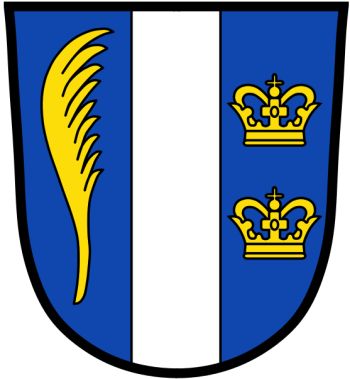Helfendorf: Difference between revisions
Knorrepoes (talk | contribs) m (Text replacement - "{{de}}" to "") |
Knorrepoes (talk | contribs) No edit summary |
||
| Line 1: | Line 1: | ||
{| class="wikitable" | |||
|- style="vertical-align:top;" | |||
|[[File:Aying.jpg|center|350 px|alt=Wappen von {{PAGENAME}}/Arms (crest) of {{PAGENAME}}]] | |||
| | |||
State : [[Bayern]]<br | '''Country''' : Germany [[File:germany.jpg|60 px|right]]<br><br><br> | ||
District (Kreis) : [[München (kreis)|München]]<br> | '''State''' : [[Bayern]][[File:Bayern.jpg|60 px|right]]<br><br><br> | ||
Incorporated into: 1978 [[Aying]] | '''District (Kreis)''' : [[München (kreis)|München]][[File:munchen.kreis.jpg|60 px|right]]<br><br><br> | ||
'''Incorporated into''':<br> | |||
* 1978 [[Aying]] | |||
|} | |||
{| class="wikitable" | {| class="wikitable" | ||
| Line 13: | Line 14: | ||
|- | |- | ||
|'''German''' | |'''German''' | ||
| | | In Blau ein silberner Pfahl; vorne ein goldener Palmzweig; hinten übereinander zwei goldene Bügelkronen. | ||
In Blau ein silberner Pfahl; vorne ein goldener Palmzweig; hinten übereinander zwei goldene Bügelkronen. | |||
|- | |- | ||
|'''English''' | |'''English''' | ||
| Line 23: | Line 23: | ||
The arms were officially granted in 1971. | The arms were officially granted in 1971. | ||
The silver pale symbolizes the Roman road from Augsburg to Salzburg, which ran through the municipal area and can still be seen today as a dam-like elevation in the field. A Roman settlement in the area has also been detected by archaeological finds. | |||
The palm leaf is the heraldic symbol of the St. Emmeram monastery in Regensburg, and commemorates the Emmeram martyrdom that is said to have taken place in 652 at the Kleinhelfendorf road station. A predecessor of the St. Emmeram Chapel built above the Marterstein can be traced back to the 8th century. The parish church was also dedicated to St. Emmeram. Kleinhelfendorf developed into a popular place of pilgrimage. | |||
The two golden crowns symbolize the Carolingian royal court in Kleinhelfendorf, which was donated in 940 by Emperor Otto I to the monastery of St. Emmeram. | |||
The color scheme in silver and blue refers to the properties of the Wittelsbach family, Dukes of Bayern. | |||
[[Civic Heraldry Literature - Germany|'''Literature''']]: | [[Civic Heraldry Literature - Germany|'''Literature''']]: | ||
Revision as of 05:43, 5 March 2023
|
Country : Germany State : Bayern District (Kreis) : München Incorporated into:
|
| German | In Blau ein silberner Pfahl; vorne ein goldener Palmzweig; hinten übereinander zwei goldene Bügelkronen. |
| English | No blazon/translation known. Please click here to send your (heraldic !) blazon or translation |
Origin/meaning
The arms were officially granted in 1971.
The silver pale symbolizes the Roman road from Augsburg to Salzburg, which ran through the municipal area and can still be seen today as a dam-like elevation in the field. A Roman settlement in the area has also been detected by archaeological finds.
The palm leaf is the heraldic symbol of the St. Emmeram monastery in Regensburg, and commemorates the Emmeram martyrdom that is said to have taken place in 652 at the Kleinhelfendorf road station. A predecessor of the St. Emmeram Chapel built above the Marterstein can be traced back to the 8th century. The parish church was also dedicated to St. Emmeram. Kleinhelfendorf developed into a popular place of pilgrimage.
The two golden crowns symbolize the Carolingian royal court in Kleinhelfendorf, which was donated in 940 by Emperor Otto I to the monastery of St. Emmeram.
The color scheme in silver and blue refers to the properties of the Wittelsbach family, Dukes of Bayern.


